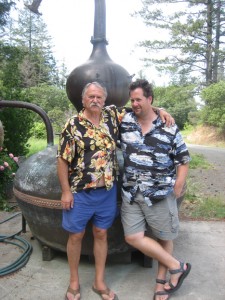A father and son distill gallons of beer into good spirits.
by Brian Yager
Back in 1999, Marko Karakasevic woke up to an overwhelming, dank aroma at his office/home-away-from-home in Mendocino County, Calif. He feared something had caught fire. Humboldt is, after all, the neighbor to the north where hops’ illicit cousin is abundant. How would he explain it to his father, Miles Karakasevic, who slept nearby? Fortuitously, the herbaciousness that permeated the air was simply the smell of distilled hops, which he should’ve expected, since he was in the process of distilling 20,000 gallons of pilsner.
It’s a 21/7 process (he sleeps three hours a night), keeping an eye on a copper alembic pot and making cuts to the distillate to ensure only the hearts—the most desirable liquid—and not the heads or tails, remain. Whiskey is a distillate made from “low wash” or “distiller’s beer,” meaning it contains the same malted grain, water and yeast that all beer has. The difference is that the beer we drink is bittered, usually with hops.
The Karakasevics, though devoted to tradition, aren’t big on convention. Given to wearing Hawaiian shirts, shorts and flip-flops, father and son continue the family trade as winemakers and distillers dating back to mid-18th-century Yugoslavia. Miles left the old country nearly 50 years ago and wound up establishing Charbay—making mostly wines and brandys—in 1983 in St. Helena, one of the Napa Valley’s idyllic enclaves. The family resides and works on the same 17 acres to this day, where Miles, 69, and Marko, 37, carry on as the 12th and 13th generation, respectively.
While they produce 29 products in all—Marko created a line of Charbay-infused vodkas that account for roughly 90 percent of their sales—it is his innovative whiskeys that are stealing his focus at this moment. They constitute nearly 2 percent of sales. But he’s working on that.
Charbay Whiskey Release I (aged for two years in neutral French Oak barrels—the same ones Miles used to make brandy in the early ’80s) was the distilled pilsner. Then came last year’s debut of Charbay Doubled and Twisted (“D&T”) made from a double IPA. It’s classified as a light whiskey (Marko hates the term “white dog”) because, rather than aging for years in charred oak barrels, it dozed all of one day in used barrels. The next batch will be Charbay IPA Light Whiskey, which started life as 6,000 gallons of Bear Republic’s highly decorated Racer 5 IPA. Marko heralded a sample of the day-old distillate at cask strength as “ridiculously smooth off the pipe.” It’s both spicy and warmly minty. Similar to blanco tequilas and white rums, you’re “tasting the whiskey, not just the barrel.”
Of course, the experimentation doesn’t end there. Crafty as Marko is, he always splits batches and puts some away in French Oak barrels. Release II (allowed to mature a total of six years in barrels and mellow for an additional four years in stainless steel) came out in 2009. French Oak-aged versions of D&T and IPA Whiskey will also make their way into the marketplace eventually.
Not incidentally, beer distills down at a rate of about 20 to one. Those 20,000 gallons of pilsner? One thousand gallons of whiskey! Then tack on the cost of storing Release II for ten years. Cask, an artisanal spirits store in San Francisco, stocks it to the tune of $340, making it one of the most expensive American whiskeys on the market. Amy Murray, Cask’s assistant manager and buyer, says the 10-year-old whiskey sells occasionally, but the D&T “is huge right now.” Customers come in asking about clear whiskeys enabling her to hand-sell D&T more than any other brand, even at $57. She always informs people that it’s made from a Double IPA, a fact that surprises everyone.
Meanwhile, back at the still, Marko isn’t finished experimenting. He’s just bought 55-gallon drums of Bear Republic’s Black Bear Stout and Hop Rod Rye “just to see.” It’s both an educational process for Marko as well as the brewery’s co-founder Richard G. Norgrove (fittingly, his father, Richard R. Norgrove, is his partner) who revealed Bear Republic plans to launch their own craft distillery by 2013. The symbiotic relationship allows the brewmaster and the master distiller to discover which malts make great whiskeys—and yes, which hops. Marko says he can never see distilling a hefeweizen. But, when informed of the burgeoning field of sour beers, asked if he’d ever toy with making a whiskey from, say, a Flanders Red, he took another sip of the IPA Light Whiskey and grinned, “I’m not against it.” •
Tasting Two: Whiskey hounds know Charbay spirits envelope-pushing drams, but it takes a beer geek to recognize their beery origins. Charbay Whiskey began as a pilsner, and after aging two years in French oak, the hop spice and toasty barley notes are still evident. D&T, on the other hand, was distilled from a double IPA and barrel-aged for all of one day; here, hops are the star,
lending the clear drink a floral,
verdant spice.


